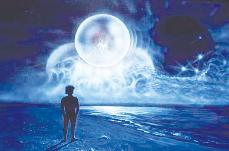Imagine, for a moment, a world where you get straight A’s. Now imagine a world where you are rich and get straight A’s. Now imagine a world where these things are true and you can control time subjectively. Where everyone can control time. Where nothing happens because everyone needs to stop time for something or other. Where all of your riches are useless because everybody controls time. Where nobody cares that you have straight A’s because everyone is going to war over this collective control of time, and you are under attack for your riches.
The multiple universe theory of physics states that these worlds may already exist.
There are four different versions of the multiple universe theory. The first, open multiuniverse theory assumes that the universe is infinite. Since information can only travel at the speed of light according to relativity, our observable universe is one of many other local universes. Therefore, somewhere at least 101023 meters (the size of our observable universe) away is a twin of yours, though with a slightly different characteristic. Since the universe is infinite, there are infinite other possibilities of worlds.
The second theory incorporates the first, stating that there are multiple open multiverses. Colloquially called the bubble theory, this interpretation sees the universe as a large froth of bubbles blowing up and popping out. These bubbles are different universes capable of holding matter. Energy fluctuations cause the creation and destruction of these different universes. Because this energy is coming from a universe already in existence- the ‘parent universe’ these bubbles will have a lot in common with the original universe though possibly more magnificent, the same way a bubble distorts reality.
The ‘Big Bounce’ physicists believe that the Big Bang was one of many creations of the universe. This means that as time progresses the universe will collapse and form another completely different universe. Since this happens infinitely, it is possible that the universe as we know it has been and will be created again and again with slight differences.
Finally, an interpretation comes out of the field of quantum mechanics. Quantum mechanics studies how atoms work through probabilistic equations. A quantum fluctuation is when matter and energy appear spontaneously out of the vacuum of space, a sort of hiccup in the energy field thought to pervade the cosmos. A quantum fluctuation may have given rise to the big bang, which led to the beginning of the universe. Therefore, quantum fluctuations could have given rise to other universes as well.
The underlying idea behind all these theories of multiple universes is that, for a universe this beautiful, that works this well, and makes this much sense to spontaneously come together is highly improbable. Uses of the multiple universe theory are helping to understand other notions of physics. For example, why is gravity so weak, that a magnet can overtake it when lifting an object? Harvard physicist Lisa Randall hypothesizes that the gravity may be leaking in through another dimension. Someday physicists may be able to put together these bubbles, bumps, leaks, and hiccups through a series of equations. Math must be used since words are not able to do justice to ideas this spectacular (math is the foreplay of physics). Until then, it seems like the best world would be one not too different from this one. One where the only difference is one that can be made in this world as well.
To read about what daily life would be like in an array of possible worlds, pick up Alan Lightman’s book “Einstein’s Dreams.”
Questions, comments, and corrections can be sent to [email protected]





















































